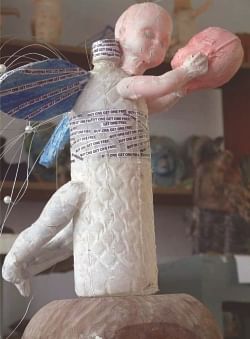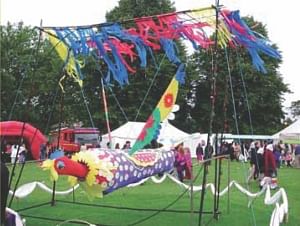| Home - Back Issues - The Team - Contact Us |
 |
| Volume 10 |Issue 38 | October 07, 2011 | |
|
|
Art Britto Something Fresh Fayza Haq
If anyone is outgoing and full of nouveau concepts, Tayeba Begum Lipi and her husband Mahbubur Rahman certainly are. Full of ready laughter and bonhomie, with “Britto”, they try to open new vistas with installations, video work– combining the knowledge of the past, with possibilities of the present, and hopes for the future. In their work they combine the east with the west. One never gets blasé with their nouveau vision. They try to bring a new interest in one's surroundings--something beyond the conventional and stereotyped two-dimensional art. Asked what they wished to capture in their work, to elaborate on the focus and aim of their ceaseless and restless efforts, with apparently no pause, since the early nineties, at the national level— Lipi says, “Much before we began 'Britto', we wanted do something different.” They also wanted to bring in new ideas from overseas, and combine them with what was there in their own culture. They wanted something more than the hackneyed water-colour, oil, mixed medias, abstract, semi-abstract and other run-of –the –mill art that one tended to decorate their homes and offices with. They did not want to shock the people with revolting, harsh images—which some artists felt were clever and new– but which were all a pale imitation of the west. The bizarre and ugly was never the aim of the couple, Lipi and Mahmud. They mean to be iconoclasts. Yet they have been going about their work with gentle and steady hands. They appear to work whenever possible and probable. They are never egoistic or full of bombast. They have won international name and fame. Yet, it was not for nothing. They fully deserve all their accolades. Back in the early nineties, says Lipi, when they began “their journey”, she was encouraged and motivated by Mahbub. At that time, she says, there was no one who did work of that type. Much before 2001, when they brought out their breathtaking new display of depicting the emptiness of false obeisance to empty rules and regulations, carried out by bigots, they had installation of Mahbub's work at Shilpakala Academy. It was conventions that they were fighting against. “It is not enough that the art world should progress. We should all aim at betterment and a beautiful, peaceful world. If many get together on the platform for betterment, there will be some promoter for this movement for something new,” says Lipi. This is not to say that Lipi and Mahmud are against painting. Their own background is Drawing and Painting in the Faculty of Fine Arts, Dhaka University. “One can conceptualise in any media, if one thinks and plans accordingly. However, here, in Bangladesh, we tend to be market oriented. In order to survive, the next generation is also basing their work on promoters and the art market. Experimentation is necessary. The artist must know how to survive and set up his own platform, in which his style and themes are preserved. We felt from the outset that there was great void in this in the art world. Individually, we have been trying to keep to our goal, Lipi and I that is. Art practice has a lot of scope in Bangladesh alone. Art practice may find a lot of change, with time. The media that focuses on art has a vast scope too. Our problem is that we are not ready to accept something that is new. Our educational system and curriculum is not wide enough to create a true artist –who projects his dreams and desires to the fullest extent,” says Mahbub. For creative practice academic education in our country is behind the times. Even the teachers, from whom art students have to learn, sometimes do not have international experience. Generation building is not the focus of these teachers. Having a secure job is what they aim at, says Mahmud. For the past two generations, taking up an unconventional career has not been easy—especially if one is not solidly backed by understanding parents etc.
How is it that they go the “untried path” – opening up new horizons at the cost of comforts? Lipi says that they did not feel any fear to do something new. This she says was because that they had a mental preparation of the difficult days ahead—they knew that their pictures would not be sold to the conventional buyers. “We were geared up for this fight to the end for searching for the new and fresh angles. Maybe some artists have different aims. Some painters and sculptors have the desire for material ends. Fame is a common aim for all artists. Working with an aim will naturally bring fame,” Lipi says. “When we examined the world, we knew we couldn't afford a car of our own; or have candle-lit dinner for two in cosy restaurants. Nevertheless we are contended with our sailing through life. It's like a sailing adventure with no bounty at the end except perhaps self- satisfaction.” says the firebrand Lipi – who manages an infectious smile, whenever the occasion arises. What is self-satisfaction for an artist? “Doing whatever we can to the best of our ability. And leaving the rest on the lap of the gods,” says Lipi, with a twinkle in her kohl-lined dark, mesmerising eyes. “We formed 'Britto' in 2002 – and know full well that we have a steady struggle ahead of us.” Touching on the subject of “Britto” Mahmud says that in order to survive, one needs a platform. The place to sit and discuss, exchange views and think ahead, however, is limited in Bangladesh, he says. The galleries, says the artists, just promotes the fixed concepts. They do not necessarily open up new windows for the artist. The couple set up “Britto” to get what is lacking in our present society. “Britto” is there for artists to experiment in an unconventional way. The artist should also be taken to some place where work can be adequately exposed. This organisation is not able to send many artists overseas. The alternative is to invite artists from abroad, he says, and to encourage local artists to find their way to residencies abroad– to get new hopes and challenges. What should be the aim of the true artist?” says Mahmud, “The artist should practice what he believes; he must work with all his heart and soul. Sincerity is a must. It is as controversial as to what is honesty in the work of an artist. Even the work that is 'factory-made' might be a sincere venture.” Asked to speak about the 116 years old Venice Bienalle, with Bangladesh having its first presentation, Lipi says, “In fact, it was South Asia's first national participation.” Five artists have been chosen — Promotesh Das Pulak, Kabir Ahmed Masum Chisty, Imran Hossain Piplu, Mahbubur Rahman and Tayeba Begum Lipi have sent in fifteen items on video art. Last year at 'Sala Uno' a gallery in Rome, Mahbubur Rahman and Tayeba Begum Lipi participated with their video art 'Videozoom Bangladesh' and received request from critics and curators to submit proposal for the Venice Biennale. Bengal Gallery was later involved to provide financial backing. The Biennale goes on till November. About 16 pigs were displayed in cages adorned with neon signs, in Mahbub's work. It had the sounds of a pig, as it screams, while it is being slaughtered. Lipi's installation was that of larger than normal size of razor blades, three thousand in all. The item pieces had been made in Old Dhaka. They formed the pattern of women's brassieres. It was called “Bizarre and the beautiful.' Her other piece contained the images of a bride and groom. The inner concept was that woman gives her entire being in marriage. Each and every one of the videos is spellbinding and awesome. They bring the young and energetic minds, which are ready to grapple with new ideas and new elements in the visual art world
Copyright (R) thedailystar.net 2011 |
||||

